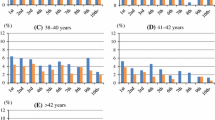Abstract
Objective: Our objective was to assess parameters associated with a successful outcome of intrauterine insemination (IUI) using cryopreserved donor sperm.
Design: We analyzed 750 consecutive donor IUI cycles undertaken by 363 women in an assisted conception clinic. The main outcome measure was clinical pregnancy.
Results: IUI was performed in 94.7% of the 750 IUI treatment cycles commenced and 180 clinical pregnancies occurred. The clinical pregnancy rate per cycle was 26.4%. The rate was significantly related to the patient's age (30.5% for age ≤35 years and 18.1% for age >35 years;P<0.006) and whether there was one or more than one preovulatory follicles [20.9, 34.4, and 31.5% for one, two, and three or four follicles with a mean diameter of 14 or more mm at the time of human chorionic gonadotropin (hCG) administration;P=0.006]. Two to four preovulatory follicles were present in 12.6% of the natural cycles, 43.6% of clomiphene citrate or tamoxifen, and 59.9% of gonadotropin stimulated cycles. The difference in the number of preovulatory follicles between stimulated and unstimulated cycles was highly significant (P<0.0001). Pregnancy rates were 29.9% in gonadotropin-stimulated cycles, 23.6% in clomiphene citrate- or tamoxifen-stimulated cycles, and 20.1% in unstimulated cycles. The difference in pregnancy rates between gonadotropin-stimulated and natural cycles was significant (P=0.038). Cycle fecundity rates were not significantly affected by the number of previous treatment cycles, duration of infertility, gravidity and parity of the patient, presence of a spontaneous luteinizing hormone (LH) surge before the administration of hCG, or number of motile sperm in the insemination specimen.
Conclusions: Success of IUI using cryopreserved donor sperm is related to the age of the women and whether there is one or more than one preovulatory follicles.
Similar content being viewed by others
References
Barratt CL, Matson DL, Holt W: British Andrology Society guidelines for the screening of semen donors for donor insemination. Hum Reprod 1993;8:1521–1523
DiMarzo SJ, Huang J, Kennedy JF, Villanueva B, Hebert SA, Young PE: Pregnancy rates with fresh versus computer-controlled cryopreserved semen for artificial insemination by donor in a private practice setting. Am J Obstet Gynecol 1990;162:1483–1488
Chaffkin LM, Nulsen JC, Luciano AA, Metzger DA: A comparative analysis of cycle fecundity rates associated with combined human gonadotropin (hMG) and intrauterine insemination (IUI) versus either hMG or IUI alone. Fertil Steril 1991;55:252–257
Tan SL, Pampiglione J, Steer C, Balen A, Mills C, Campbell S: Transvaginal peritoneal oocyte and sperm transfer for the treatment of nontubal infertility. Fertil Steril 1992;57:850–853
Ord T, Patrizio P, Marello E, Balmaceda JP, Asch RH: Mini-Percoll: A new method of semen preparation for IVF in severe male factor infertility. Hum Reprod 1990;5:987–989
Hurd WW, Randolph JF Jr, Ansbacher R, Menge AC, Ohl DA, Brown AN: Comparison of intracervical, intrauterine, and intratubal techniques for donor insemination. Fertil Steril 1993;59:339–342
Depypere HT, Gordts S, Campo R, Comhaire F: Methods to increase the success rate of artificial insemination with donor semen. Hum Reprod 1994;9:661–663.
Patton PE, Burry KA, Thurmond A, Novy MJ, Wolf DP: Intrauterine insemination outperforms intracervical insemination in a randomized, controlled study with frozen, donor semen. Fertil Steril 1992;57:559–564
Mackenna AI, Zegers-Hochschild F, Fernandez EO, Fabres CV, Huidobro CA, Guadarrama AR: Intrauterine insemination: Critical analysis of a therapeutic procedure. Hum Reprod 1992;7:351–354
Tan SL, Royston P, Campbell S, Jacobs HS, Betts J, Mason B, Edwards RG: Cumulative conception and livebirth rates after in-vitro fertilisation. Lancet 1992;339:1390–1394
Shenfield F, Doyle P, Valentine A, Steele SJ, Tan SL: Effects of age, gravidity and male infertility status on cumulative conception rates following artificial insemination with cryopreserved donor semen: Analysis of 2998 cycles of treatment in one centre over 10 years. Hum Reprod 1993;8:60–64
Federman CA, Dumesic DA, Boone WR, Shapiro SS: Relative efficiency of therapeutic donor insemination using a luteinizing hormone monitor. Fertil Steril 1990;54:489–492
Tan SL, Doyle P, Campbell S, Beral V, Rizk B, Brinsden P, Mason B, Edwards RG: Obstetric outcome of in vitro fertilization pregnancies compared with normally conceived pregnancies. Am J Obstet Gynecol 1992;167:778–784
Uribarren A, Aranguren G, Rodriguez-Escudero FJ, Martinez AJ, Neyro JL: Selective embryo reduction in a sextuplet pregnancy. Fertil Steril 1990;53:1102–1103
Author information
Authors and Affiliations
Rights and permissions
About this article
Cite this article
Pittrof, R.U., Shaker, A., Dean, N. et al. Success of intrauterine insemination using cryopreserved donor sperm is related to the age of the woman and the number of preovulatory follicles. J Assist Reprod Genet 13, 310–314 (1996). https://doi.org/10.1007/BF02070144
Received:
Accepted:
Issue Date:
DOI: https://doi.org/10.1007/BF02070144




